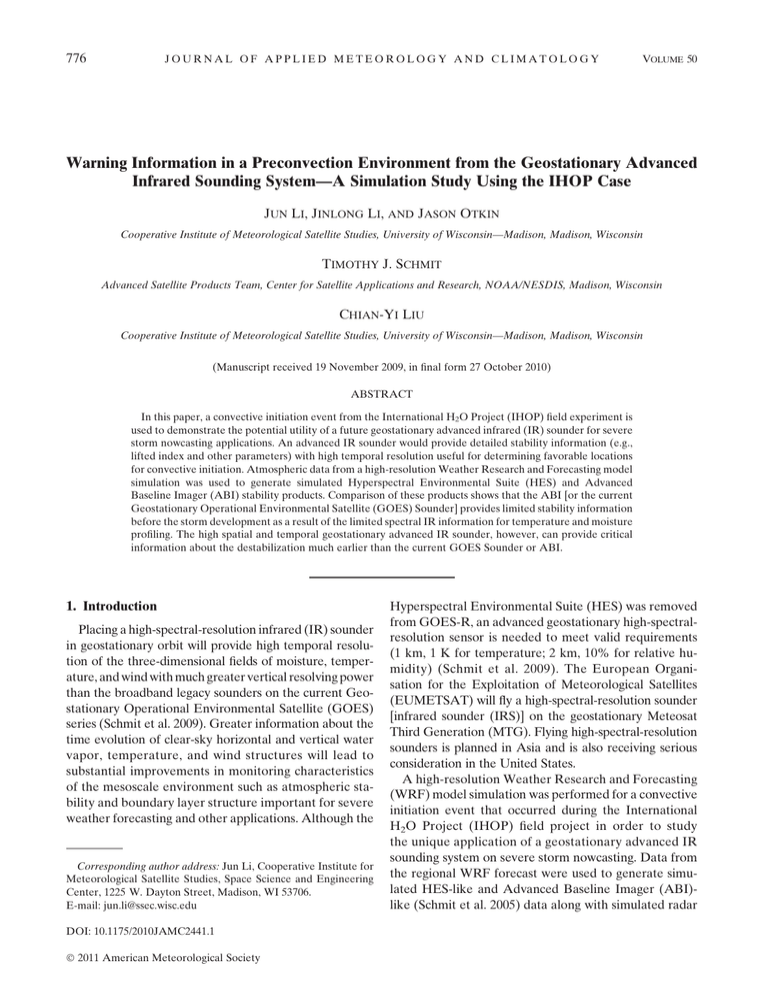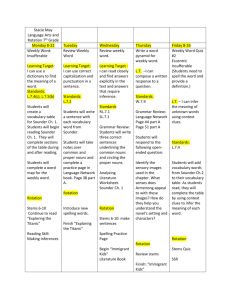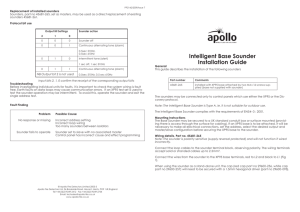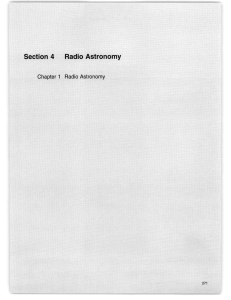Warning Information in a Preconvection Environment from the Geostationary Advanced
advertisement

776 JOURNAL OF APPLIED METEOROLOGY AND CLIMATOLOGY VOLUME 50 Warning Information in a Preconvection Environment from the Geostationary Advanced Infrared Sounding System—A Simulation Study Using the IHOP Case JUN LI, JINLONG LI, AND JASON OTKIN Cooperative Institute of Meteorological Satellite Studies, University of Wisconsin—Madison, Madison, Wisconsin TIMOTHY J. SCHMIT Advanced Satellite Products Team, Center for Satellite Applications and Research, NOAA/NESDIS, Madison, Wisconsin CHIAN-YI LIU Cooperative Institute of Meteorological Satellite Studies, University of Wisconsin—Madison, Madison, Wisconsin (Manuscript received 19 November 2009, in final form 27 October 2010) ABSTRACT In this paper, a convective initiation event from the International H2O Project (IHOP) field experiment is used to demonstrate the potential utility of a future geostationary advanced infrared (IR) sounder for severe storm nowcasting applications. An advanced IR sounder would provide detailed stability information (e.g., lifted index and other parameters) with high temporal resolution useful for determining favorable locations for convective initiation. Atmospheric data from a high-resolution Weather Research and Forecasting model simulation was used to generate simulated Hyperspectral Environmental Suite (HES) and Advanced Baseline Imager (ABI) stability products. Comparison of these products shows that the ABI [or the current Geostationary Operational Environmental Satellite (GOES) Sounder] provides limited stability information before the storm development as a result of the limited spectral IR information for temperature and moisture profiling. The high spatial and temporal geostationary advanced IR sounder, however, can provide critical information about the destabilization much earlier than the current GOES Sounder or ABI. 1. Introduction Placing a high-spectral-resolution infrared (IR) sounder in geostationary orbit will provide high temporal resolution of the three-dimensional fields of moisture, temperature, and wind with much greater vertical resolving power than the broadband legacy sounders on the current Geostationary Operational Environmental Satellite (GOES) series (Schmit et al. 2009). Greater information about the time evolution of clear-sky horizontal and vertical water vapor, temperature, and wind structures will lead to substantial improvements in monitoring characteristics of the mesoscale environment such as atmospheric stability and boundary layer structure important for severe weather forecasting and other applications. Although the Corresponding author address: Jun Li, Cooperative Institute for Meteorological Satellite Studies, Space Science and Engineering Center, 1225 W. Dayton Street, Madison, WI 53706. E-mail: jun.li@ssec.wisc.edu DOI: 10.1175/2010JAMC2441.1 Ó 2011 American Meteorological Society Hyperspectral Environmental Suite (HES) was removed from GOES-R, an advanced geostationary high-spectralresolution sensor is needed to meet valid requirements (1 km, 1 K for temperature; 2 km, 10% for relative humidity) (Schmit et al. 2009). The European Organisation for the Exploitation of Meteorological Satellites (EUMETSAT) will fly a high-spectral-resolution sounder [infrared sounder (IRS)] on the geostationary Meteosat Third Generation (MTG). Flying high-spectral-resolution sounders is planned in Asia and is also receiving serious consideration in the United States. A high-resolution Weather Research and Forecasting (WRF) model simulation was performed for a convective initiation event that occurred during the International H2O Project (IHOP) field project in order to study the unique application of a geostationary advanced IR sounding system on severe storm nowcasting. Data from the regional WRF forecast were used to generate simulated HES-like and Advanced Baseline Imager (ABI)like (Schmit et al. 2005) data along with simulated radar MARCH 2011 NOTES AND CORRESPONDENCE 777 FIG. 1. (left) The simulated radar image and (right) the total precipitable water (TPW) product overlaying the 11-mm brightness temperature (BT) cloudy image from the GOES-11 Sounder at 2245 UTC 12 Jun 2002. reflectivity to demonstrate the unique value of a high temporal-resolution advanced IR sounder on severe storm forecasts by depicting the unstable region in the preconvective storm environment. ABI on board the next generation of GOES (the GOES-R series) will be used to continue the current GOES Sounder products (Menzel et al. 1998) before an advanced IR sounder is realized (Schmit et al. 2008; Jin et al. 2008). The ABI and the current GOES Sounders only provide limited stability information due to the limited spectral IR information for vertical atmospheric temperature and moisture profiling. The simulation with the IHOP case demonstrates that the high spatial and high temporal geostationary advanced IR sounder can provide valuable information about the environmental destabilization much earlier than the current GOES Sounder or ABI. Schmit et al. (2008) has concluded that when combined with the forecast information, ABI is able to provide the similar atmospheric profiles of the current GOES Sounder, and ABI will be used to continue the current GOES Sounder legacy products before an advanced sounder is placed on a GOES satellite. 2. The IHOP storm case and WRF forecast On 12 June 2002 during IHOP, two significant convective storm systems developed over northern Texas and the Nebraska–Oklahoma border. To study the utility of a high-temporal-resolution advanced IR sounder in the preconvective storm environment, version 3.0.1 of the WRF model (Skamarock et al. 2005; Skamarock and Klemp 2008) was used to perform a high-spatial-resolution simulation of this event. The simulation was initialized at 0600 UTC 12 June 2002 using 20-km Rapid Update Cycle (RUC) data below 100 hPa and 18 Global Forecasting System (GFS) analyses above this level. A double-nested domain configuration covering a large portion of the central United States with 6-km and 2-km horizontal grid spacing, respectively, was employed. The vertical resolution decreased from ,100 m in the lowest km to ;625 m at the model top, which was set to 25 hPa. To better simulate the timing and location of the convective initiation, the simulation was nudged toward the RUC and GFS analyses during a 6-h spinup period using the WRF four-dimensional data assimilation (FDDA) system (Stauffer and Seaman 1990). Subgrid-scale processes were parameterized using the Thompson et al. (2008) mixed-phase microphysics scheme, the Mellor–Yamada– Janjic planetary boundary layer scheme (Mellor and Yamada 1982), and the Dudhia (1989) shortwave and Rapid Radiative Transfer Model (RRTM; Mlawer et al. 1997) longwave radiation schemes. Surface heat and moisture fluxes were calculated using the Noah land surface model. 3. Geostationary IR observation simulation experiment for severe storm nowcasting applications The WRF model output was used to simulate the ABI and hyperspectral IR (e.g., HES like) radiances with assumed noise characteristics. The spectral resolution for the ABI-like instrument is around 15–100 cm21, while the HES-like instrument has a spectral resolution on the order of 1 cm21 (Schmit et al. 2009). In clear skies, a fast radiative transfer model called the Pressure Layer Fast 778 JOURNAL OF APPLIED METEOROLOGY AND CLIMATOLOGY VOLUME 50 FIG. 2. (a) The clear-sky LI (color regions) from true fields, (b) the clear-sky LI from HES-like simulations, (c) the simulated radar reflectivity, and (d) the clear-sky LI from ABI/GOES Sounder–like simulations at 1300 UTC 12 Jun 2002. The black–white regions in the LI plot are the cloud-top temperature from WRF model output, while red color shows the extreme unstable area. Algorithm for Atmospheric Transmittances (PFAAST; Hannon et al. 1996) has been used to simulate the ABI- and HES-like radiances; this model has 101 pressure level vertical coordinates from 0.05 to 1100 hPa. The fast transmittance model uses Line-by-Line Radiative Transfer Model (LBLRTM; version 8.4; Clough and Iacono 1995) calculations and the high-resolution transmission molecular absorption spectroscopic database HITRAN 2000 (Rothman et al. 1992) with updates (aer_hitran_ 2000_updat_01.1, available online at http://www.hitran. com). The calculations take into account the satellite zenith angle, absorption by well-mixed gases (including nitrogen, oxygen, and carbon dioxide), water vapor (including the water vapor continuum), and ozone. The cloudy radiances are calculated by coupling the clear-sky optical thickness from PFAAST with the associated cloud optical thickness (COT) at 0.55 mm. The COT is calculated with a fast radiative transfer cloud model developed by University of Wisconsin—Madison (UW) and Texas A&M University (Wei et al. 2004). The original model, designed for hyperspectral IR sounders, is also adapted to ABI. In this cloudy radiative transfer model, the bulk single-scattering properties of ice crystals are calculated by assuming aggregates for large particles (.300 mm), hexagonal geometries for moderate particles (50–300 mm), and droxtals for small particles (0–50 mm); the water cloud droplet is assumed to be spherical and the classical Lorenz–Mie theory is used to calculate the singlescattering properties. Without introducing significant bias, the surface IR emissivities are assumed to be 0.98 for this case study. The WRF model output serves as the ‘‘truth’’ dataset and the radar reflectivity; ABI and HES radiances are simulated in both clear and cloudy skies, whereas the ABI- and HES-like radiances in clear skies are further converted to atmospheric temperature and moisture profile retrievals using a one-dimensional variational algorithm (Li et al. 2000). Note that the atmospheric profile retrieval from the IR radiances is independent of the forecast in this IHOP simulation experiment. Only clear-sky retrievals are performed since we want to focus our study on the atmospheric instability prior the storm MARCH 2011 NOTES AND CORRESPONDENCE 779 FIG. 3. As in Fig. 2, but for 1700 UTC 12 Jun 2002. development, cloudy soundings were not used in these simulations. To evaluate the WRF modeled data for the simulation, we have compared the simulated radar image and the total precipitable water (TPW) product overlaid on the independent 11-mm brightness temperature (BT) cloudy image from the GOES-11 Sounder at 2245 UTC 12 June 2002 (Fig. 1). The simulated radar image and the GOES-11 measurements agree well; in fact, the WRF model predicts the two convective cloud systems (northern Texas and the Kansas–Oklahoma border) in the correct locations. Lifted index (LI) in units of degrees Celsius (8C) provides an estimate of the atmospheric stability in cloudfree areas and is one of the most popular satellite-derived products. The LI (Galway 1956) expresses the temperature difference between a lifted parcel and the surrounding air at 500 hPa. The parcel is lifted dry adiabatically from the mean lowest 100-hPa level to the condensation level, and then wet adiabatically to 500 hPa. When an air parcel is lifted adiabatically from the surface, the atmosphere is considered potentially unstable if the parcel’s temperature at 500 hPa is less than its environment (i.e., LI , 0). Based on experience, the LI has the following meteorological implications for storm development: LI . 0 K for stable, 23 K , LI , 0 K for marginally unstable, 26 K , LI , 23 K for moderately unstable, 29 K , LI , 26 K for very unstable, and LI , 29 K for extremely unstable. The likelihood of severe thunderstorm development increases as the LI becomes more negative, with LI values less than 26 K indicative of very favorable thermodynamic conditions for severe thunderstorm development. LI can be used together with other products such as convective available potential energy (CAPE), convective inhibition (CIN), total precipitable water, and derived atmospheric motion vectors (AMVs) to improve severe storm nowcasting. The LI is computed from the temperature profiles; therefore, the true LI from WRF model output (forecast), the ABI-like LI and HES-like LI from temperature profile retrievals, can be derived to demonstrate the nowcasting application of an advanced IR sounder’s data in the preconvective storm environment. Simulated radar reflectivity based on a Rayleigh scattering assumption (Blahak 2007) was also computed in order to more clearly indicate where convective activity occurred during this event. Figure 2 shows the LI (color regions) 780 JOURNAL OF APPLIED METEOROLOGY AND CLIMATOLOGY VOLUME 50 FIG. 4. As in Fig. 2, but for 1800 UTC 12 Jun 2002. from the true field (Fig. 2a), LI from HES-like simulations (Fig. 2b), a simulated radar image (Fig. 2c), and LI from ABI-like (or the current GOES Sounder) simulations (Fig. 2d) at 1300 UTC 12 June 2002. The black/white regions show the cloud-top temperature from WRF model. Figures 3–5 are the same as Fig. 2 but for 1700, 1800, and 2100 UTC, respectively. These time intervals reflect significant atmospheric dynamic changes in the preconvective storm environment. At 1300 UTC (Fig. 2), the HES-like simulations show that extremely unstable conditions have developed over central Oklahoma, similar to that of the truth depicted by the WRF model simulation, whereas the ABI/GOES Sounder–like simulations show an environment containing much less potential instability. The significant difference between HES-like and GOES Sounder LI can be attributed to the vertical resolution: a geostationary advanced sounder with high spectral resolution and more than 1000 channels in the infrared region would provide critical measurements on the time evolution of horizontal and vertical water vapor and temperature structures with high vertical resolution and accuracy (1 km, 1 K for temperature; 2 km, 10% for relative humidity) (Schmit et al. 2009) Such measurements would be an unprecedented source of information on the dynamic and thermodynamic atmospheric fields, which would benefit nowcasting and numerical weather prediction (NWP) applications. For comparison, the current GOES Sounder has only 18 broad spectral IR bands and thus provides temperature and moisture profiles with limited vertical resolution and accuracy. Schmit et al. (2008) has demonstrated that ABI IR radiances can be used together with forecast information to continue the current GOES Sounder products. An information content analysis was also conducted to demonstrate that both the current GOES Sounder and ABI have limited vertical information and accuracy for atmospheric profiling when compared with advanced IR sounders (Schmit et al. 2009; Liu et al. 2010, manuscript submitted to Geophys. Res. Lett.). As opposed to the satellite-based LI product, the radar does not provide atmospheric dynamic structure information about the prestorm environment, but once the convective storm is developed, the radar data provide very good information about the precipitation. Four hours later (at 1700 UTC; Fig. 3), the ABI/GOES Sounder shows extreme instability but misplaces the MARCH 2011 NOTES AND CORRESPONDENCE 781 FIG. 5. As in Fig. 2, but for 2100 UTC 12 Jun 2002. most unstable regions. For example, the ABI/GOES Sounder provides false instability in the southeastern Oklahoma compared with the true field (Fig. 3a). This occurs because the low-spectral resolution ABI/GOES Sounder data are not able to clearly separate the skin temperature from the surface emissivity and provide less information about the temperature and moisture profiles. At 1800 UTC (Fig. 4), both HES-like and ABI/ GOES Sounder data clearly show the extreme instability, but the ABI/GOES Sounder is less accurate when compared with the truth (Fig. 4a). After another 3 h (at 2100 UTC; Fig. 5) the radar imagery shows a convective precipitation signal; the rain signature in the radar corresponds to a severe thunderstorm complex that developed during the next few hours. In this example, a severe thunderstorm occurred at 2100 UTC 12 June 2002 (see Fig. 5). Eight hours before the storm (1300 UTC) the region is mostly clear and relatively dry as indicated by the total precipitable water (not shown). Figure 6 shows the relative humidity cross section at 2000 UTC 12 June 2002 from true (Fig. 6a) and from the geostationary advanced IR sounder (Fig. 6b), ABI (Fig. 6c), and RUC (Fig. 6d). It can be seen that in the region where the severe storm developed 1 h later (circled area), the moist air is lifted into the drier 700– 600-hPa atmospheric layer, which increases the atmospheric instability and induces the storm development. The HES-like sounder depicts the moisture vertical structures similar to the truth, while the ABI does not depict this feature since it has only three broadband water vapor absorption bands. Using information and inverse theory (Li and Huang 1999; Liu et al. 2008), both hyperspectral and broadband low-spectral-resolution sounder/imager profile capability can be intercompared with high confidence. This demonstrates that HES retrievals can offer additional information on clear air moisture (and thermodynamic instability) not already captured in high-resolution NWP models. Using satellite-derived LI as an example in this IHOP case study, HES clearly demonstrates improved prestorm warning information when compared with ABI and the current GOES sounder, but it should be also noted that LI is not the only index for storm nowcasting. It should be used with other satellite-derived stability indices such as CAPE and CIN, as well as with other products such as NWP model output, surface 782 JOURNAL OF APPLIED METEOROLOGY AND CLIMATOLOGY VOLUME 50 FIG. 6. Relative humidity cross section at 2000 UTC 12 Jun 2002 from (a) true, (b) the geostationary advanced IR sounder, (c) ABI, and (d) RUC. observations, and products such as convective initiation from imager measurements for nowcasting. If the high- temporal-resolution and high-accuracy HESretrieved sounding data can be further assimilated into NWP model, this will certainly increase the accuracy of NWP forecast. 4. Summary This IHOP case study described in this paper demonstrates that an advanced geostationary hyperspectral IR sounder has the potential to improve our ability to monitor and predict the onset of severe thunderstorm activity. In this example, the HES-like instrument provided important information about extreme destabilization several hours earlier than the ABI or the current GOES Sounder. An HES-like instrument also provides accurate LI information with about 4-h lead time than the RUC model (not shown). In summary, a hyperspectral geostationary IR sounder has the advantage of providing more realistic vertical temperature and moisture information, an important benefit to nowcasting and regional NWP applications. With a high-spectral-resolution IR sensor in geostationary orbit, the nowcasting and short-term forecasts (0–6 h) for severe weather will be improved as a result of better monitoring of lowlevel moisture and temperature conditions. Acknowledgments. The authors thank Dr. Mitchell D. Goldberg at Center for Satellite Applications and Research for his suggestions on geostationary sounder simulations using IHOP. Ralph Petersen is also thanked. The views, opinions, and findings contained in this report are those of the authors and should not be construed as an official National Oceanic and Atmospheric Administration or U.S. government position, policy, or decision. This study is partly supported by NOAA Grant NA06NES4400002. MARCH 2011 NOTES AND CORRESPONDENCE REFERENCES Blahak, U., 2007: RADAR_MIE_LM and RADAR_MIELIB— Calculation of radar reflectivity from model output. Internal Report, Institute for Meteorology and Climate Research, University/Research Center Karlsruhe, 150 pp. Clough, S. A., and M. J. Iacono, 1995: Line-by-line calculations of atmospheric fluxes and cooling rates. 2: Applications to carbon dioxide, ozone, methane, nitrous oxide and the halocarbons. J. Geophys. Res., 100, 16 519–16 535. Dudhia, J., 1989: Numerical study of convection observed during the Winter Monsoon Experiment using a mesoscale twodimensional model. J. Atmos. Sci., 46, 3077–3107. Galway, J. G., 1956: The lifted index as a predictor of latent instability. Bull. Amer. Meteor. Soc., 37, 528–529. Hannon, S., L. L. Strow, and W. W. McMillan, 1996: Atmospheric infrared fast transmittance models: A comparison of two approaches. Optical Spectroscopic Techniques and Instrumentation for Atmospheric and Space Research II, P. B. Hays and J. Wang, Eds., International Society for Optical Engineering (SPIE Proceedings, Vol. 2830), 94–105. Jin, X., J. Li, T. J. Schmit, J. Li, M. D. Goldberg, and J. J. Gurka, 2008: Retrieving clear-sky atmospheric parameters from SEVIRI and ABI infrared radiances. J. Geophys. Res., 113, D15310, doi:10.1029/2008JD010040. Li, J., and H.-L. Huang, 1999: Retrieval of atmospheric profiles from satellite sounder measurements by use of the discrepancy principle. Appl. Opt., 38, 916–923. ——, W. Wolf, W. P. Menzel, W. Zhang, H.-L. Huang, and T. H. Achtor, 2000: Global soundings of the atmosphere from ATOVS measurements: The algorithm and validation. J. Appl. Meteor., 39, 1248–1268. Liu, C.-Y., J. Li, E. Weisz, T. J. Schmit, S. A. Ackerman, and H. L. Huang, 2008: Synergistic use of AIRS and MODIS radiance measurements for atmospheric profiling. Geophys. Res. Lett., 35, L21802, doi:10.1029/2008GL035859. Mellor, G. L., and T. Yamada, 1982: Development of a turbulence closure model for geophysical fluid problems. Rev. Geophys. Space Phys., 20, 851–875. 783 Menzel, W. P., F. C. Holt, T. J. Schmit, R. M. Aune, A. J. Schreiner, G. S. Wade, and D. G. Gray, 1998: Application of GOES-8/9 soundings to weather forecasting and nowcasting. Bull. Amer. Meteor. Soc., 79, 2059–2077. Mlawer, E. J., S. J. Taubman, P. D. Brown, M. J. Iacono, and S. A. Clough, 1997: Radiative transfer for inhomogeneous atmospheres: RRTM, a validated correlated-k model for the longwave. J. Geophys. Res., 102, 16 663–16 682. Rothman, L. S., and Coauthors, 1992: The HITRAN molecular database: Editions of 1991 and 1992. J. Quant. Spectrosc. Radiat. Transfer, 48, 469–507. Schmit, T. J., M. M. Gunshor, W. P. Menzel, J. J. Gurka, J. Li, and A. S. Bachmeier, 2005: Introducing the next-generation Advanced Baseline Imager on GOES-R. Bull. Amer. Meteor. Soc., 86, 1079–1096. ——, J. Li, J. J. Gurka, M. D. Goldberg, K. Schrab, J. Li, and W. Feltz, 2008: The GOES-R ABI (Advanced Baseline Imager) and the continuation of GOES-N class sounder products. J. Appl. Meteor. Climatol., 47, 2696–2711. ——, ——, S. A. Ackerman, and J. J. Gurka, 2009: High-spectraland high-temporal-resolution infrared measurements from geostationary orbit. J. Atmos. Oceanic Technol., 26, 2273–2292. Skamarock, W. C., and J. B. Klemp, 2008: A time-split nonhydrostatic atmospheric model for weather research and forecasting applications. J. Comp. Phys., 227, 3465–3485. ——, ——, J. Dudhia, D. O. Gill, D. M. Barker, W. Wang, and J. G. Powers, 2005: A description of the Advanced Research WRF, version 2. NCAR Tech. Note/TN-4681STR, 88 pp. Stauffer, D. R., and N. L. Seaman, 1990: Use of four-dimensional data assimilation in a limited-area mesoscale model. Part I: Experiments with synoptic-scale data. Mon. Wea. Rev., 118, 1250–1277. Thompson, G., P. R. Field, R. M. Rasmussen, and W. D. Hall, 2008: Explicit forecasts of winter precipitation using an improved bulk microphysics scheme. Part II: Implementation of a new snow parameterization. Mon. Wea. Rev., 136, 5095–5115. Wei, H., P. Yang, J. Li, B. B. Baum, H.-L. Huang, S. Platnick, Y. Hu, and L. Strow, 2004: Retrieval of semitransparent ice cloud optical thickness from Atmospheric Infrared Sounder (AIRS) measurements. IEEE Trans. Geosci. Remote Sens., 42, 2254–2267.



